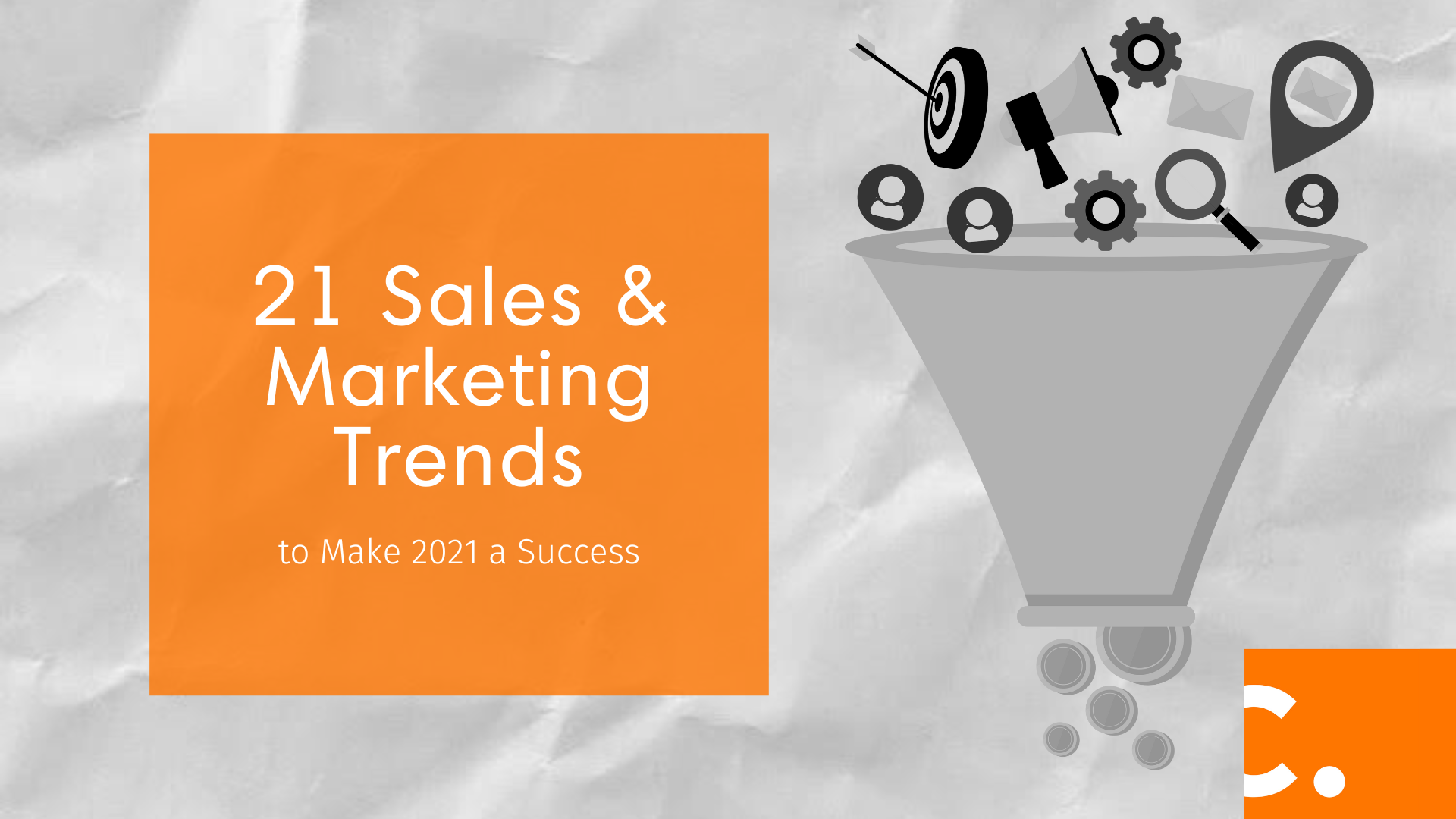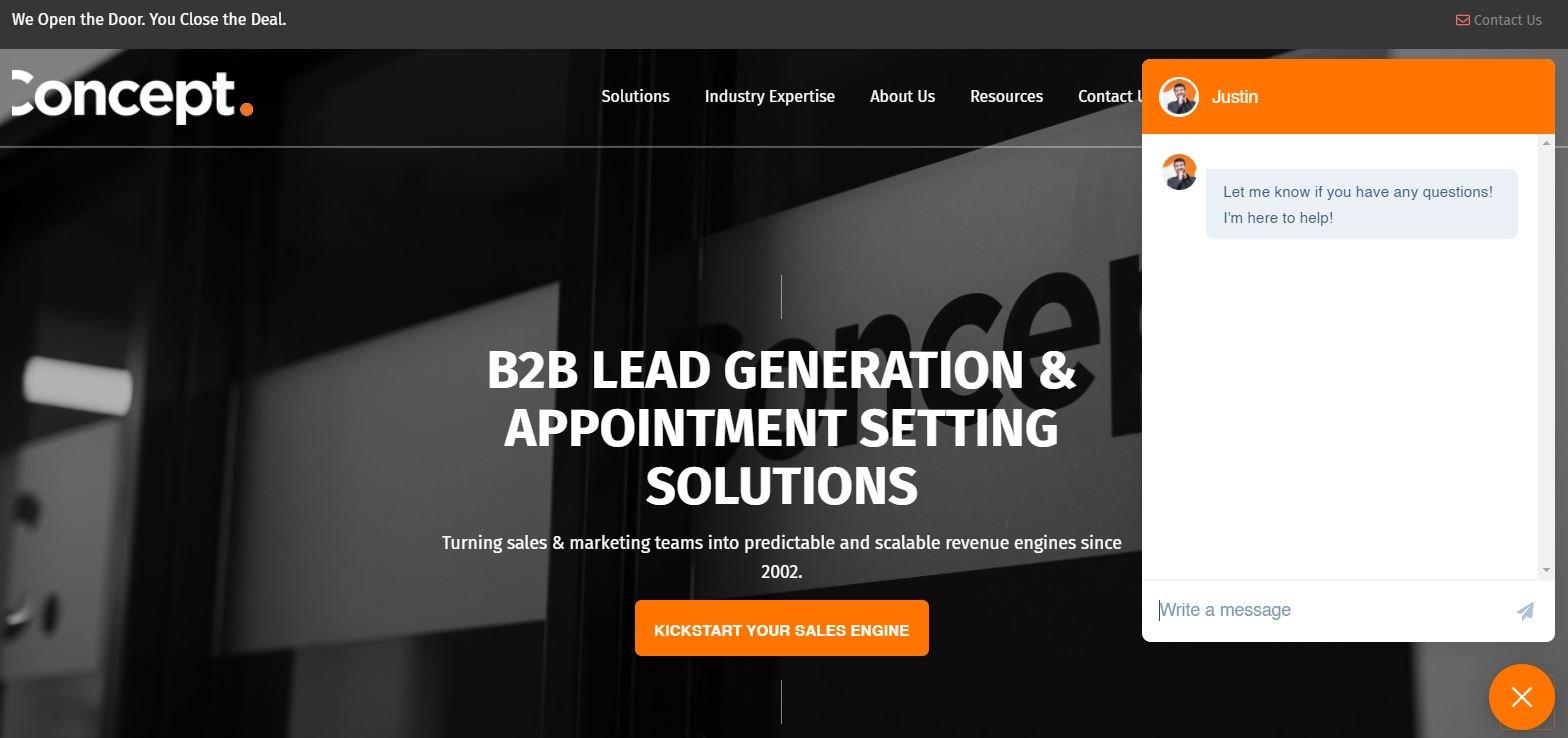
We all know that 2020 was a year of change that affected every industry in the global marketplace, and it's particularly true for those that work in sales and marketing. We were forced to evolve the way we engage with our customers. Some of these abrupt changes brought new challenges, and others forced an evolution that was long overdue.
2021 will be a year of experimentation to adapt to this new environment, and will usher in a new era sales and marketing for B2B organizations. Kick this year off on the right foot by incorporating some or all of these sales and marketing trends for 2021.
Sales Trends
Sales Intelligence Technology Utilization
Similar to the marketing trends of using AI to help gain insight and improve performance with digital campaigns, sales intelligence technology is key to targeting the right prospects for outbound sales development. We ranked some sales intelligence technology tools in 2020. See which ones provided the best overall tools for our sales development representatives.
Sales Outreach Video Utilization
Due to the pandemic in 2020, businesses had to quickly figure out how to work remotely, including holding sales meetings virtually. Video sales meetings were rough throughout 2020 as various industries tried to incorporate this specific platform to their everyday life. In 2021, sales video meetings need to be more refined and project the cutting-edge company you represent.
Other bonuses to sales video meetings include:
- Not only do sales video meetings allow your sales team to stay safe but it also increases productivity overall.
- Sales video meetings also allow prospects and client the ability to put a face with a name virtually. It helps build a strong professional relationship through the addition of body language and voice (tone and inflection).
- Since your sales team isn’t spending as much time traveling to in-person sales meetings, they are able to spend more time focused on lead nurturing.
Prospect Surveys
As everyone tries to improve work efficiencies, a newer tactic is utilizing short surveys sent to prospects before the initial sales meeting. This can help reduce the time spent doing discovery, but can also help prepare sales teams with valuable information prior to the meeting. Most people are comfortable with completing short surveys to provide greater insight into their goals and needs. It's crucial to keep these simple to make it easy for prospects to participate.
Adding a short survey prior to the initial sales meeting utilizes marketing automation that includes an automated email and workflow. This way your sales team doesn’t have to send individual emails to all prospects. Marketing automation allows you to do the work upfront and project the appearance of one-to-one communications.
Chatbot Utilization
Chatbots are being utilized more on websites to answer simpler questions and giving your sales team / customer service team more time to focus on more complex tasks. And chatbot software has drastically improved with cross-platform integration over the last several years making them more relevant and useful.
The purpose of a chatbot is to get simple, basic information to the visitor like order status or simple technical issues. HubSpot offers chatbots that are easily customized for your company’s specific needs. Let technology help your business become more efficient and effective.

Personalized Professional Relationships
The majority of businesses transitioned to remote work in 2020, and people started to feel less connected with doing all aspects of the job. A key to success for salespeople in 2021 is to build a more personalized, professional relationship with prospects and clients. Building an authentic relationship will cement your position as a sales / thought leader and equate to more closed wins. Maintaining relationships will be a challenging, yet rewarding endeavor in 2021.
Performance Dashboards and OKRs
Having clearly defined goals and objectives are essential to a sales team’s success. Remote working has caused some new challenges with communicating performance. Utilizing dashboards and OKRs in your CRM like Salesforce or HubSpot can give your sales team a snapshot of sales goals and opportunities. With clearly defined goals, your team can achieve more, while knowing exactly where they stand with the organization.

Use of Multi-Channel, Personalized Experiences
With the changes in 2020 to work and shopping done online, a new challenge has emerged – unknown buyer’s journey. It’s become harder to figure out where in the sales funnel a prospect has entered, so utilizing the same approach or tactic isn’t ideal.
Various channels - like email, paid search, content marketing (blogs and guides), social media, mass media (TV, radio, outdoor) – offers many ways (their preferred way) for a prospect to enter your sales funnel. Tying performance with each channel is key to refining your sales and marketing strategies for future campaigns.
Webinar Tactic for Lead Generation
Do you have tips and tricks to help prospects with their problem? Webinars are a key tool to not only provide an education resource but for lead generation too. Since you are a subject matter expert (SME) with your service or product, sharing a webinar on helpful recommendations can turn those prospects into leads in your sales funnel through authenticity and expertise.

Make Customer Experience a Tool for Lead Generation
Playing off the use of chatbot tools, businesses can improve their bottom line by providing a strong customer experience. Seventy six percent of B2B buyers prefer to speak with someone when making a purchase according to Finances Online and McKinsey. A conversation through chat on your website or chatbot utilization has shown to produce more repeat customers.
Integrate CRM into Your Sales Team
CRM is a powerful tool that allows you to forecast sales, maintain current contact information, track prospect and client exchanges, and manage inventory. CRM can help enhance your sales team’s productivity through detailed interactions from marketing emails, outbound calling, one-to-one emails, and other tasks.
Other ways CRM gives your business the power to close more deals include:
Reporting: Create important operational reports for your business, so you can see how things are performing at-a-glance.
Automation: Stop relying on individual team members to execute each of these activities, effectively leveraging a marketing automation platform can improve efficiencies and save both time and money.
Forecasting: Utilize sales forecasting which can help your sales teams accurately predict future sales growth based on their pipeline of potential deals.

Increased Sales Training and Coaching
The need for well-training, polished sales professionals is on the rise. With many people dealing with the fallout from 2020 lay-offs, so many are being forced to change their career path. As companies try to recoup their losses, the importance on new sales is higher than ever. In influx of new sales professionals paired with the need to get them ramped up quickly, will force organizations to rethink the way they onboard, train, and continuously develop their teams. Growth and development of your sales team will give you a leg up on the competition, while also building loyalty with your core staff.
Close the Gap Between Sales and Marketing
Sales and marketing has typically worked in their own silos. In the new sales and marketing environment brought on by the pandemic, it’s more important than ever that sales and marketing work together to provide seamless content and service to prospects and clients. Get more tips on reducing your sales and marketing pain points.

Marketing Trends
Virtual Events
There is still much to learn about virtual events, but one thing is for certain they are here to stay in some capacity. CES (Consumer Electronics Show) is the largest trade show event in the United States attracting more than 180,000 attendees to Las Vegas each January. The event typically spans several convention centers in the city, totaling over two million square feet of occupied floor space.
In January 2021, CES went completely virtual, which is an enormous feat for a convention that has thousands of businesses attending and hundreds of panels, presentations, and keynotes happening every day. While the event will undoubtedly return to its physical home in Las Vegas, the takeaway is that it will permanently become a hybrid event.
Something that brands can learn from virtual or hybrid events, is that virtually attending an industry event can have an even greater impact than attending an event physically. Many brands attending CES reported record traffic, conversions, and meaningful interactions over the span of the event in comparison to previous years. Companies that can embrace virtual or hybrid events are going to have a significant competitive advantage. Instead of missing events in your marketing toolkit as a networking and lead generation tactic, companies that are willing to make the jump to virtual events may increase the usefulness of that channel.
Engagement Through Personalization
While large virtual conferences have taken up much of the headlines, it’s important to note that smaller, more personal online events are also positioned to have a substantial impact in 2021. Webinars, training, company events, workshops, product demos are all now more accessible and less expensive to conduct. The important aspect of this to note is while these types of smaller, more personal virtual events were already becoming more popular in recent years, they have now been expedited to the norm.
At Concept, we have embraced these smaller virtual events as part of our routine and have helped several clients incorporate small virtual events into their businesses. We know from prior years that these types of interactions with employees, customers, and prospects were growing but now, businesses that do not leverage more personal digital events as a means of communication will start to fall behind their competitors.
Customer-Centric Branding Will Grow
Customer-centric branding is a simple concept that whatever is best for your customer, will eventually be best for your company in the long term. It sounds simple, right? It is simple but it certainly is not easy. Being able to lead your brand with a customer focus, means you need to have a depth of customer understanding. Harvard Business Review recently published “Beyond Big Data” and found that 88% of executives agree that understanding the customer is “very important” for effectively managing the customer experience. When asked how well your organization understands why its customers do what they do, only 23% of executives said: “very well."
So, we can see that while it is universally accepted that understanding your customers is incredibly important, gaining that insight organizationally is more challenging. Organizations that focus on customer needs will often avoid a short-term win if it does not provide long-term value. Of course, that pop-up ad may reliably convert existing customers as a cross-sell to a complimentary product… but how did the 99% of customers that had to close it feel? What did it communicate about how you value their time and their focus?
Companies are now using customer data to better understand customer’s behavior, and then translating that data to human, personal and thoughtful strategies about how to meet those needs.

Next Level A/B Testing
Marketing automation is a growing field of study and with advancements in machine learning over the past few years, the insight that can be gained from A/B testing is growing and implementing is easier than ever. Every marketing effort should have a clear, intended action and A/B testing helps bring clarity to what variables you can introduce to help encourage conversions on those activities.
If you are not introducing A/B testing into your 2021 marketing plan, know that your competitors are, if they have not already. At Concept, as Hubspot Platinum Partner, we see the immediate impact regular testing for performance can have for any given business. Hubspot is one of the tools for landing pages, lead forms, email, call to action items, and more to test the statistical significance of changes in marketing materials.
Our CRM consulting and implementation team has implemented Hubspot for a vast number of our clients with phenomenal results. If marketing automation is new to your business, we can not only get you started but help you optimize your efforts through your entire funnel. If you would like to learn more, Hubspot’s Complete A/B Testing Kit is a great resource.

Conversational Content Marketing
Content is a customer experience, yet content marketers have long relied on keyword-heavy blog posts as the main tactic to drive traffic. This strategy is better suited for Google, but not for people.
In 2021, marketers should focus on building an authentic content experience for audiences. Content has to be more personalized and feel like a conversation. Provide your audience with the most relevant and useful information by develop content around actual conversations with industry experts.
It’s time to move away from a “keyword search” mindset and shift towards “conversational search.” Develop content around theoretical conversations being had around your products and services.
Utilize Digital Marketing Strategies to Do More with Less Budget
If you are like most businesses, budgets often fluctuate and require a lot of resourcefulness from departments and teams. Marketing departments are no different and in the changing economic landscape of 2020, many marketing leaders found themselves with less to spend in 2021.
We predict that this year will be a time where many marketing teams will be looking to optimize every part of their marketing operations to accommodate a reduced budget.
The good news is, many marketing operations do have room to improve in this area and it can be done. We assist many of our clients with optimizing their paid media spend, being selective with which channels to apply limited resources to, and how to maximize the desired performance result with highly specific campaigns.
While a budget reduction is always a tough reality, the truth is that is entirely possible to continue to preform at a very high level with some focus and creativity.
Marketing Personalization
We strongly believe that many brands and businesses will continue to evolve from a “universal marketing” approach to a more personalized approach. With so much data available from the multitude of channels using information such as industry, company, job title, engagement method, engagement type, age, and response time can give endless opportunities to engage a potential customer at their level.
Salesforce reported recently that personalized promotions for email have 29% higher unique open rates and 41% higher unique click rates. The impact that these kinds of improvements can have on the ROI of your marketing efforts cannot be overstated. Audience analytics, segmentation, and dynamic content are all tools that we will see deployed in many industries and businesses this year.

Adding Value through Machine Learning & AI
While deep learning and artificial intelligence might seem like tools that are out of reach for the average marketer, the reality is, many of the tools we already use have components of this technology. You might ask, what is the purpose of machine learning in marketing? The purpose is to be able to anticipate the needs of your prospects earlier and perhaps better than they could articulate themselves.
When you can anticipate a prospect’s problem faster and offer a comprehensive solution, competitors will struggle to connect with those prospects and their interactions will be less meaningful.
Machine learning is also being leveraged to predict customer churn risk for businesses. If you can build a risk model that identifies behavior in your customers that typically relates to cancellation of a product or service, it gives an opportunity to intervene on a personal level. For many businesses, retention marketing is a growing discipline and these kinds of tools help to understand not just why prospects become customers, but also when they might be likely leave and how you can help.
Avoid Single-Channel Marketing Strategies
Even as some companies are cutting their marketing budgets in 2021, it doesn’t make sense to consolidate budget in a single channel. Brands are constantly competing for consumer’s attention and you can’t break through the noise using only one channel.
Cross-channel marketing employs several tactics, but is tailored to the consumer’s behavior. Each tactic builds off the previous tactic to increase the impact of your marketing campaigns. Typical omni-channel marketing campaigns include targeted ads, email blasts, and maybe some blog posts. While you are marketing across channels, the messaging may seem fragmented to the consumer. An example of cross-channel marketing would include a consumer engaging with blog post related to a specific topic, then receiving a marketing email related to the blog topic and finally see a target ad on social media. Each tactic is related to the consumer’s initial engagement and most relevant to their needs.
Local Search Engine Optimization
We are constantly studying trends in search engine optimization and we see that many businesses are ignoring the area that they serve as an important data set to optimize for. Optimizing your website, social media profiles, and online marketing materials so search engines understand the geographical regions you are focused on has a lot of benefits. One of the key benefits of this is the reduced competition for organic rankings. Ranking in the first few positions for a competitive service or product type can seem very daunting and, in some cases, nearly impossible. Many businesses would have a much easier time ranking for a combination keyword of the type of service and the city or region they focus on.
Google’s 2018 Marketing Statistics report showed a 900% increase in users searching for a business or service with “near me” or a region in their searches and there is plenty of evidence that this trend is accelerating to the tune of 250% year over year through 2020.
Making your target geographic location known to users and search engines does not prohibit you from getting business or prospects from other areas. It will, however, increase your profile and organic traffic when users indicate a preferred geographical region.
Either strategically, or out of habit, users are searching with a location in mind, and not optimizing for that trend will be a missed opportunity for many.
Utilizing Employees for Brand Evangelism
Brand evangelism is converting individuals (your employees) into “super fans” of your products or services. With most people working remotely, it has become more challenging for brands to sell products or services due to lack of personalization.
Since in-person interaction is scarce, your business needs to find new ways of reaching prospects. Brand evangelism allows for your best and most knowledgeable fans, aka your employees, to sell your business. It gives credibility and an authentic interaction.
From LinkedIn: “When employees share information on social media, their posts go 561% farther than corporate posts. Brand messages distributed by employees are re-shared 24 times more often than if they come straight from the brand.”
Partner With Concept
Share your details and our team will reach out to discuss collaboration opportunities

